#web scraper in india
Explore tagged Tumblr posts
Text
The process of gathering information from multiple sources—including websites, databases, spreadsheets, documents, text files, and more—is known as data scraping. Data integration, migration, analysis, and information retrieval are just a few of the uses for data scraping.
#data scraping#data scraping service providers#data scraping company#data scraping services company#data scraping services company in india#data scraping services#web scraper in india#Data integration
1 note
·
View note
Text
News Extract: Unlocking the Power of Media Data Collection
In today's fast-paced digital world, staying updated with the latest news is crucial. Whether you're a journalist, researcher, or business owner, having access to real-time media data can give you an edge. This is where news extract solutions come into play, enabling efficient web scraping of news sources for insightful analysis.

Why Extracting News Data Matters
News scraping allows businesses and individuals to automate the collection of news articles, headlines, and updates from multiple sources. This information is essential for:
Market Research: Understanding trends and shifts in the industry.
Competitor Analysis: Monitoring competitors’ media presence.
Brand Reputation Management: Keeping track of mentions across news sites.
Sentiment Analysis: Analyzing public opinion on key topics.
By leveraging news extract techniques, businesses can access and process large volumes of news data in real-time.
How News Scraping Works
Web scraping involves using automated tools to gather and structure information from online sources. A reliable news extraction service ensures data accuracy and freshness by:
Extracting news articles, titles, and timestamps.
Categorizing content based on topics, keywords, and sentiment.
Providing real-time or scheduled updates for seamless integration into reports.
The Best Tools for News Extracting
Various scraping solutions can help extract news efficiently, including custom-built scrapers and APIs. For instance, businesses looking for tailored solutions can benefit from web scraping services India to fetch region-specific media data.
Expanding Your Data Collection Horizons
Beyond news extraction, companies often need data from other platforms. Here are some additional scraping solutions:
Python scraping Twitter: Extract real-time tweets based on location and keywords.
Amazon reviews scraping: Gather customer feedback for product insights.
Flipkart scraper: Automate data collection from India's leading eCommerce platform.
Conclusion
Staying ahead in today’s digital landscape requires timely access to media data. A robust news extract solution helps businesses and researchers make data-driven decisions effortlessly. If you're looking for reliable news scraping services, explore Actowiz Solutions for customized web scraping solutions that fit your needs.
#news extract#web scraping services India#Python scraping Twitter#Amazon reviews scraping#Flipkart scraper#Actowiz Solutions
0 notes
Text
Extract Laptop Resale Value from Cashify
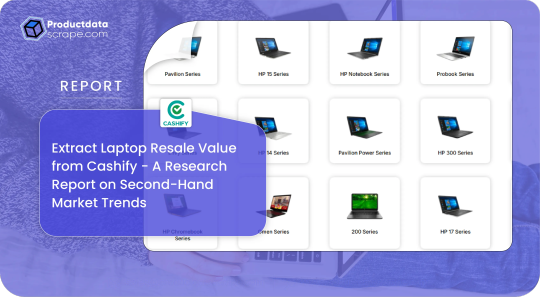
Introduction
In India’s fast-evolving second-hand electronics market, Cashify has emerged as a leading platform for selling used gadgets, especially laptops. This research report investigates how to Extract laptop resale value from Cashify, using data-driven insights derived from Web scraping laptop listings from Cashify and analyzing multi-year pricing trends.
This report also explores the potential of building a Cashify product data scraping tool, the benefits of Web Scraping E-commerce Websites, and how businesses can leverage a Custom eCommerce Dataset for strategic pricing.
Market Overview: The Rise of Second-Hand Laptops in India
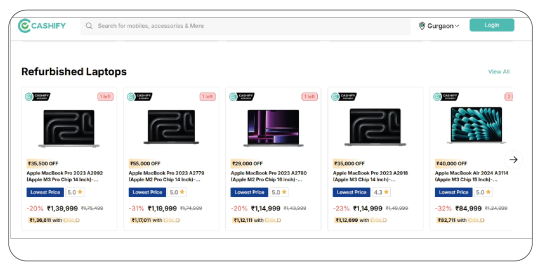
In India, the refurbished and second-hand electronics segment has witnessed double-digit growth over the last five years. Much of this boom is driven by the affordability crisis for new electronics, inflationary pressure, and the rising acceptance of certified pre-owned gadgets among Gen Z and millennials. Platforms like Cashify have revolutionized this space by building trust through verified listings, quality checks, and quick payouts. For brands, resellers, or entrepreneurs, the ability to extract laptop resale value from Cashify has become crucial for shaping buyback offers, warranty pricing, and trade-in deals.
Web scraping laptop listings from Cashify allows stakeholders to get a clear, real-time snapshot of average selling prices across brands, conditions, and configurations. Unlike OLX or Quikr, where listings can be inconsistent or scattered, Cashify offers structured data points — model, age, wear and tear, battery health, and more — making it a goldmine for second-hand market intelligence. By combining this structured data with a Cashify product data scraping tool, businesses can identify underpriced segments, negotiate better supplier rates, and create competitive refurbished offerings.
With millions of laptops entering the resale loop every year, the scope of scraping and analyzing Cashify’s data goes far beyond academic interest. For retailers, this data can translate into practical business actions — from customizing trade-in bonuses to launching flash sale campaigns for old stock. The bigger goal is to build an adaptive pricing model that updates dynamically. This is where Web Scraping Cashify.in E-Commerce Product Data proves indispensable for data-driven decision-making.
Technology & Tools: How to Scrape Laptop Prices from Cashify India
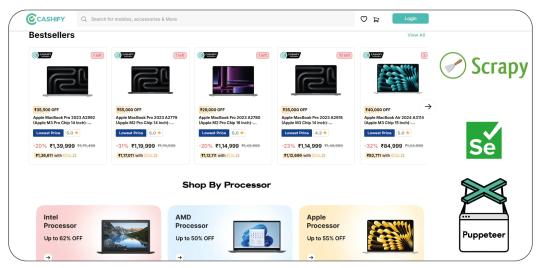
Building an efficient pipeline to scrape laptop prices from Cashify India demands more than just basic scraping scripts. Cashify uses dynamic content loading, pagination, and real-time pricing updates, which means your scraper must be robust enough to handle AJAX calls, handle IP blocks, and store large datasets securely. Many modern scraping stacks use Python libraries like Scrapy, Selenium, or Puppeteer, which can render JavaScript-heavy pages and pull detailed product listings, price fluctuations, and time-stamped snapshots.
Setting up a Cashify web scraper for laptop prices India can help businesses automate daily price checks, generate real-time price drop alerts, and spot sudden changes in average resale value. Combining this with a smart notification system ensures refurbishers and second-hand retailers stay one step ahead of market fluctuations.
Additionally, deploying a custom eCommerce dataset extracted from Cashify helps link multiple data points: for example, pairing model resale values with the original launch price, warranty status, or historical depreciation. This layered dataset supports advanced analytics, like predicting when a specific model’s resale value will hit rock bottom — an insight invaluable for maximizing margins on bulk procurement.
A good Cashify product data scraping tool should include error handling, proxy rotation, and anti-bot bypass methods. For larger operations, integrating this tool with CRM or ERP software automates workflows — from setting competitive buyback quotes to updating storefront listings. Ultimately, the technical strength behind web scraping e-commerce websites is what makes data actionable, turning raw pricing into real profit.
Opportunities: Turning Scraped Cashify Data into Business Strategy
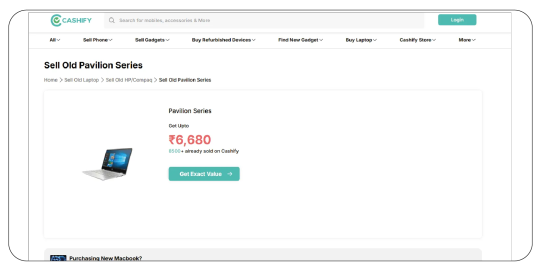
Once you extract laptop resale value from Cashify, the next step is turning this raw pricing intelligence into a clear business advantage. For individual resellers, knowing the exact resale price of a MacBook Air or HP Pavilion in real-time can mean the difference between a profit and a loss. For larger refurbishing chains or online marketplaces, scraped data powers dynamic pricing engines, localized offers, and even targeted marketing campaigns for specific models or city clusters.
For instance, with a robust Cashify.com laptop pricing dataset India, a company can forecast upcoming spikes in demand — say during the start of the academic year when students buy affordable laptops — and stock up on popular mid-range models in advance. Additionally, trends in price drop alerts help predict when it’s cheaper to buy in bulk. With a Cashify web scraper for laptop prices India, these insights update automatically, ensuring no opportunity is missed.
Beyond pricing, the data can reveal supply gaps — like when certain brands or specs become scarce in specific cities. Using Web Scraping Solutions, retailers can then launch hyperlocal campaigns, offering better trade-in deals or doorstep pickups in under-supplied zones. This level of precision turns simple scraping into a strategic tool for growth.
In summary, the real power of web scraping laptop listings from Cashify lies not just in collecting prices, but in transforming them into a sustainable, profitable second-hand business model. With a solid scraping stack, well-defined use cases, and data-driven action plans, businesses can stay ahead in India’s booming refurbished laptop market.
Key Insights
Growing Popularity of Used Laptops
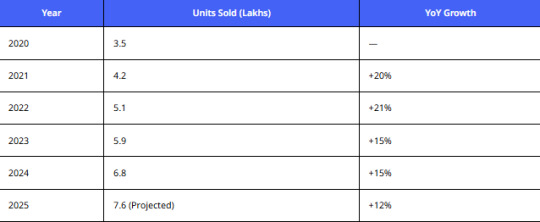
Analysis:
With over 7 million units projected for 2025, there’s a clear demand for affordable laptops, boosting the need to extract laptop resale value from Cashify for resale arbitrage and trade-in programs.
Average Resale Value Trend
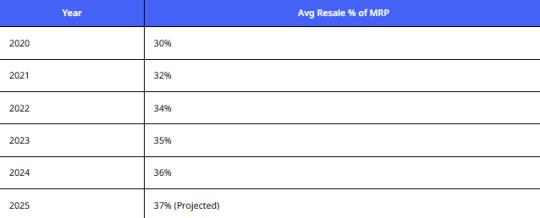
Analysis:
Consumers get back an average of 30–37% of the original price. This data justifies why many refurbishers and dealers scrape laptop prices from Cashify India to negotiate smarter buyback deals.
Brand-wise Resale Premium
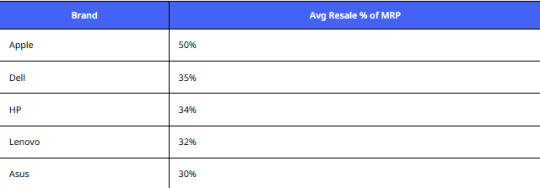
Analysis:
Apple retains the highest value — a key insight for businesses using a Cashify.com laptop pricing dataset India to optimize refurbished stock.
Price Drop Alerts Influence
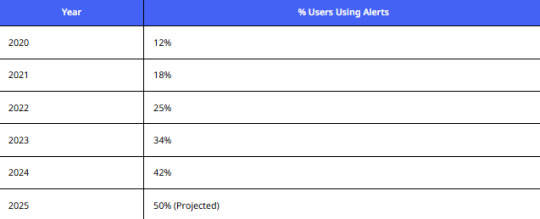
Analysis:
More users want real-time price drop alerts for laptops on Cashify, pushing resellers to deploy a Cashify web scraper for laptop prices India to monitor and react instantly.
Average Listing Time Before Sale
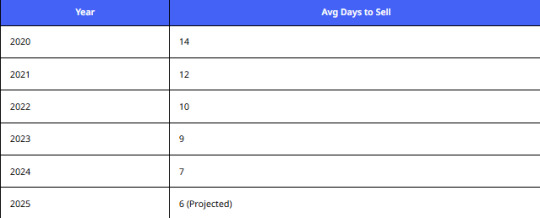
Analysis:
Faster selling cycles demand real-time tracking. Extract laptop resale value from Cashify in near real-time with a robust Cashify product data scraping tool.
Popular Price BracketsPrice Band (INR)% Share< 10,00020%10,000–20,00045%20,000–30,00025%>30,00010%
Analysis:
The ₹10k–₹20k band dominates, highlighting why Web Scraping Cashify.in E-Commerce Product Data is crucial for budget-focused segments.
Urban vs Rural Split

Analysis:
Growth in rural demand shows the need for local price intelligence via Web Scraping Solutions tailored for regional buyers.
Top Cities by Resale Listings
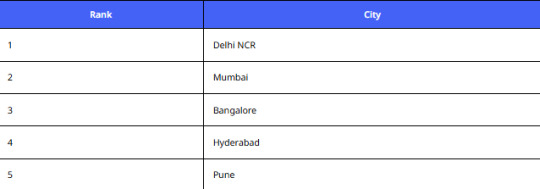
Analysis:
A Custom eCommerce Dataset from Cashify helps brands target these hubs with region-specific offers.

Analysis:
Cashify’s stronghold makes web scraping laptop listings from Cashify vital for second-hand market trend research.
Projected Market Value
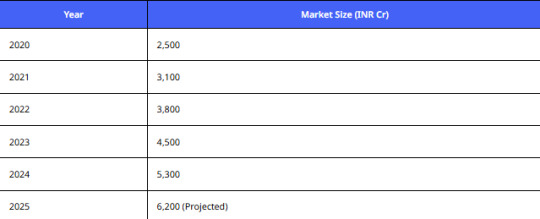
Analysis:
The second-hand laptop market will surpass INR 6,000 Cr by 2025 — a clear opportunity to build a Cashify web scraper for laptop prices India and lead the arbitrage game.
Conclusion
From real-time price tracking to building custom pricing datasets, this research shows that to stay ahead in the resale game, businesses must extract laptop resale value from Cashify with smart Web Scraping E-commerce Websites strategies. Ready to unlock hidden profits? Start scraping smarter with a custom Cashify product data scraping tool today!
Know More >> https://www.productdatascrape.com/extract-laptop-resale-value-cashify-market-trends.php
#ExtractLaptopResaleValueFromCashify#WebScrapingLaptopListingsFromCashify#ScrapeLaptopPricesFromCashifyIndia#CashifyComLaptopPricingDatasetIndia#CashifyProductDataScrapingTool#WebScrapingEcommerceWebsites
0 notes
Text
Web Scraping Meesho: Unlocking Reseller and Social Commerce Data
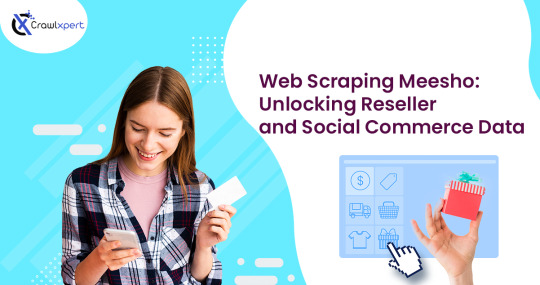
Introduction
In the evolving landscape of Indian e-commerce, Meesho has emerged as a revolutionary platform that blends traditional retail with the power of social selling. Founded in 2015, Meesho enables millions of small businesses, homepreneurs, and resellers—especially women—to launch online storefronts via WhatsApp, Instagram, and Facebook. It’s not just an e-commerce site—it’s an ecosystem built on reseller entrepreneurship and social commerce.
With more than 100 million downloads and hundreds of thousands of products listed across categories like fashion, home décor, electronics, and personal care, Meesho presents a rich dataset for analysts, developers, and marketers. Whether you're trying to understand reseller pricing patterns, monitor product trends, or evaluate how social commerce behaviors vary by region, web scraping Meesho can offer deep insights.
Extracting product listings, prices, reviews, and seller data
Analyzing reseller trends, margins, and sales dynamics
Understanding Meesho’s category and social sharing structure
Building tools for price comparison, reseller dashboards, or trend analysis
Staying compliant with Meesho’s policies and ethical standards
Understanding Meesho’s Ecosystem and Why Scrape It
What Makes Meesho Unique in Indian E-Commerce
Choose products from Meesho’s catalog
Set a custom price above Meesho’s base price
Share the product via WhatsApp, Facebook, or Instagram
Earn profit margins directly from the difference
Who Can Benefit from Scraping Meesho
Market researchers analyzing social commerce growth
Developers building price comparison or reseller tracking tools
D2C brands looking to benchmark pricing and reseller demand
Analytics teams interested in demand mapping and category trends
Affiliate marketers and business consultants evaluating fast-moving goods
What Data You Can Extract from Meesho
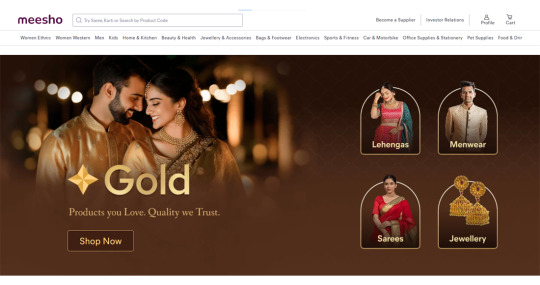
Tools and Tech Stack for Scraping Meesho
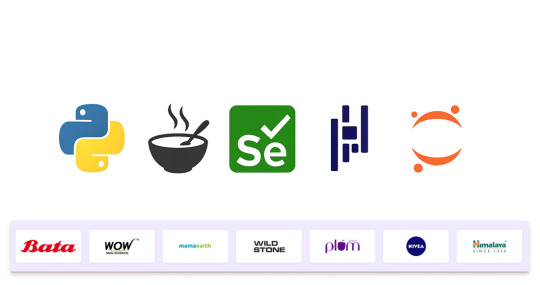
Python – The go-to programming language for web scraping
BeautifulSoup – For parsing HTML of static pages
Selenium or Playwright – For interacting with dynamic elements and lazy loading
Pandas – For cleaning and analyzing scraped data
Jupyter Notebook / VS Code – IDEs for iterative development
Building a Basic Scraper (Static Content)
import requests from bs4 import BeautifulSoup headers = {'User-Agent': 'Mozilla/5.0'} url = 'https://www.meesho.com/kurtis-women/pl/3yu' response = requests.get(url, headers=headers) soup = BeautifulSoup(response.text, 'html.parser') products = soup.find_all('div', class_='sc-dfVpRl') for item in products: title = item.find('p', class_='sc-papXJ').text price = item.find('h4').text print(f"Title: {title} | Price: {price}")
Handling Pagination and Dynamic Loading
from selenium import webdriver from selenium.webdriver.common.by import By import time driver = webdriver.Chrome() driver.get('https://www.meesho.com/kurtis-women/pl/3yu') for i in range(10): driver.execute_script("window.scrollTo(0, document.body.scrollHeight);") time.sleep(2) product_names = driver.find_elements(By.CLASS_NAME, 'sc-papXJ') for p in product_names: print(p.text) driver.quit()
Real-Time Use Cases for Scraped Meesho Data
Reseller Profitability Analysis
Calculate average profit margins across categories
Track how much resellers can make during the festive vs. off-season
Benchmark margins for similar SKUs across regions
Trend Forecasting in Indian Fashion
Which products are labeled “Most Loved” or “Top Rated”?
What colors, patterns, or fabric types dominate Meesho listings?
Are there spikes in certain categories (e.g., ethnic wear during Diwali)?
Social Sharing and Viral Listings
Products shared most frequently (via URL frequency analysis)
User-generated tags and keywords used in product descriptions
Patterns in word-of-mouth-driven conversions
Conclusion: Meesho as a Social Commerce Goldmine
Meesho’s meteoric rise is not just a testament to its business model but to India’s grassroots e-commerce revolution. By enabling resellers across small towns and cities to participate in the digital economy, Meesho has democratized selling—and along the way, generated a vast trail of pricing, inventory, and product data.
Building smart dashboards for reseller performance
Tracking fast-moving SKUs and seasonal pricing swings
Understanding consumer behavior via reviews and ratings
Creating regional discount maps for different states
Just remember: Always scrape ethically, avoid hitting servers with too many requests, and respect data usage terms. Done responsibly, scraping Meesho offers one of the richest datasets for understanding India’s fast-growing social commerce frontier.
Know More : https://www.crawlxpert.com/blog/Web-Scraping-Meesho-Unlocking-Reseller-and-Social-Commerce-Data
0 notes
Text
Web Scraping Blinkit Reviews Data: Unlocking Real-Time Customer Insights

In today’s data-driven age, customer reviews are invaluable assets. For businesses looking to understand real-time consumer sentiment, Web Scraping Blinkit Reviews Data offers a goldmine of insights. As Blinkit (formerly Grofers) continues to dominate the hyperlocal delivery space in India, its user-generated reviews reveal what customers genuinely feel about products, pricing, and service quality.
Why Scrape Blinkit Reviews Data?

Collecting and analyzing reviews manually is inefficient. Instead, using a Blinkit Reviews Scraper enables you to extract large volumes of structured, relevant feedback in real time. Whether you’re an FMCG brand, data analyst, or eCommerce strategist, scraping Blinkit reviews data helps uncover product strengths, detect recurring complaints, and track market trends.
With a robust Blinkit Reviews Data Extractor, businesses gain access to:
Star ratings and review text
Customer sentiment over time
Localized purchasing patterns
Pricing feedback and perceived value
Feature requests and product improvement areas
These insights can power everything from smarter product development to targeted marketing campaigns.
Tools to Scrape Blinkit Reviews Data

To efficiently scrape Blinkit reviews data, businesses can rely on tools like:
Python + BeautifulSoup: Great for small-scale extraction
Selenium or Puppeteer: Ideal for dynamic, JavaScript-heavy pages
Scrapy: For scalable, robust data pipelines
Third-party APIs: For faster deployment without coding
With the right tool, you can automate the entire extraction process and store the reviews in formats like CSV or JSON for deeper analysis.
Real-World Benefits of Blinkit Reviews Data Scraping

Product Innovation: Use customer suggestions to launch better products.
Market Trend Detection: Spot rising product categories or shifting customer preferences.
Localized Campaigns: Analyze reviews city-wise using a tailored Blinkit Reviews Data strategy.
Competitive Benchmarking: See how your brand stacks up against competitors.
Legal and Ethical Considerations

Before deploying a Blinkit Reviews Scraper, always review Blinkit’s Terms of Service and robots.txt file. Respect rate limits and ensure your scraping practices are ethical and compliant. For internal research and analytics, data extraction is typically allowed — but redistribution of scraped content may have restrictions.
Conclusion With customer feedback shaping modern commerce, Web Scraping Blinkit Reviews Data is no longer optional — it’s essential. Whether you use a custom script or a ready-to-use Blinkit Reviews Data Extractor, you’re opening the door to deeper customer understanding and smarter decisions. Don’t just guess what your users want — scrape Blinkit reviews data and know for sure.
Ready to extract insights from reviews?
Let Datazivot help you get started with the right tools today.
#BlinkitReviews#WebScraping#DataScraping#ReviewData#SentimentAnalysis#EcommerceData#DataExtractor#ScrapeReviews
0 notes
Text
Web Scraping Explained: A Guide to Ethical Data Extraction

Web scraping is a technique used to automatically extract information from websites. Instead of manually copying and pasting data, web scraping uses programs that can read and collect information from web pages efficiently. It has become a popular tool among professionals who require large volumes of data for research, analysis, or business intelligence. In this article, we’ll explain what web scraping is, how it works, and why ethical practices matter—along with the value of working with a trusted website designing company in India to guide your digital strategy.
What Is Web Scraping?
Web scraping allows computers to mimic how a human browses the web and extracts data. The process typically involves sending requests to a website's server, receiving the HTML code in response, and then parsing that code to collect specific pieces of data such as product prices, contact details, or user reviews. The collected information is often stored in databases or spreadsheets for further analysis.
Many developers prefer to use programming languages like Python for web scraping due to its simplicity and robust libraries like Beautiful Soup and Scrapy. These tools make it easier to navigate through the structure of websites and extract meaningful information quickly.
When working with a professional website designing company in India, businesses can ensure that their web scraping efforts are seamlessly integrated into their digital platforms and follow best practices for compliance and performance.
Common Applications of Web Scraping
Web scraping is used across various industries and for multiple purposes:
E-commerce: Online retailers monitor competitor pricing and gather product data to adjust their own strategies.
Market Research: Companies collect customer feedback or product reviews to better understand consumer sentiment.
Journalism: Reporters use scraping tools to gather facts and track news stories.
Academia & Research: Researchers compile large datasets for analysis and insights.
By partnering with an experienced website designing company in India, businesses can implement web scraping tools that are tailored to their unique goals and ensure that they operate efficiently and ethically.
The Importance of Ethical Web Scraping
As powerful as web scraping is, it comes with significant ethical responsibilities. One of the primary concerns is consent. Extracting data from a website without permission can violate terms of service or even infringe on privacy laws.
Another important consideration is respecting the robots.txt file—a public document that outlines which parts of a website can be accessed by automated tools. Responsible scrapers always check this file and adhere to its guidelines.
Additionally, any data collected must be used responsibly. If you're using the data for commercial purposes or sharing it publicly, ensure that it doesn’t include personal or sensitive information without consent. Ethical data use not only protects individuals but also builds trust in your brand.
A reliable website designing company in India can help ensure your scraping solutions comply with legal standards and align with industry best practices.
Best Practices for Ethical Web Scraping
To ensure your scraping strategy is responsible and sustainable, keep the following tips in mind:
Review the Website’s Terms of Service: Understand what is and isn’t allowed before scraping.
Respect robots.txt: Follow the website’s guidelines to avoid prohibited areas.
Limit Your Request Frequency: Too many requests in a short time can slow down or crash a site. Adding delays between requests is a good practice.
Protect User Data: Always anonymize personal information and never share sensitive data without proper consent.
These practices help avoid legal trouble and ensure your scraping activity doesn’t negatively impact other websites or users. A reputable website designing company in India can also implement these controls as part of your digital infrastructure.
Real-World Applications and Professional Support
Small businesses and startups often use web scraping for competitive analysis, such as tracking product pricing or consumer trends. When used correctly, this method offers valuable insights that can lead to better business decisions.
To build scraping tools that are efficient, secure, and aligned with your business goals, consider working with a professional website designing company in India. Agencies like Dzinepixel have helped numerous businesses create secure and scalable platforms that support ethical data collection methods. Their experience ensures your scraping projects are both technically sound and compliant with privacy laws and web standards.
Final Thoughts
Web scraping is a powerful tool that can unlock valuable data and insights for individuals and businesses. However, with this power comes the responsibility to use it ethically. Understanding how web scraping works, respecting site guidelines, and using data responsibly are all crucial steps in making the most of this technology.
If you're planning to incorporate web scraping into your digital strategy, it’s wise to consult with a professional website designing company in India. Their expertise can help you develop robust solutions that not only deliver results but also maintain ethical and legal standards.
By taking the right steps from the beginning, you can benefit from the vast potential of web scraping—while building a trustworthy and future-ready online presence.
#best web development agencies india#website design and development company in india#website development company in india#web design company india#website designing company in india#digital marketing agency india
0 notes
Text
Web Scraping Explained: A Guide to Ethical Data Extraction

Web scraping is a technique used to automatically extract information from websites. Instead of manually copying and pasting data, web scraping uses programs that can read and collect information from web pages efficiently. It has become a popular tool among professionals who require large volumes of data for research, analysis, or business intelligence. In this article, we’ll explain what web scraping is, how it works, and why ethical practices matter—along with the value of working with a trusted website designing company in India to guide your digital strategy.
What Is Web Scraping?
Web scraping allows computers to mimic how a human browses the web and extracts data. The process typically involves sending requests to a website's server, receiving the HTML code in response, and then parsing that code to collect specific pieces of data such as product prices, contact details, or user reviews. The collected information is often stored in databases or spreadsheets for further analysis.
Many developers prefer to use programming languages like Python for web scraping due to its simplicity and robust libraries like Beautiful Soup and Scrapy. These tools make it easier to navigate through the structure of websites and extract meaningful information quickly.
When working with a professional website designing company in India, businesses can ensure that their web scraping efforts are seamlessly integrated into their digital platforms and follow best practices for compliance and performance.
Common Applications of Web Scraping
Web scraping is used across various industries and for multiple purposes:
E-commerce: Online retailers monitor competitor pricing and gather product data to adjust their own strategies.
Market Research: Companies collect customer feedback or product reviews to better understand consumer sentiment.
Journalism: Reporters use scraping tools to gather facts and track news stories.
Academia & Research: Researchers compile large datasets for analysis and insights.
By partnering with an experienced website designing company in India, businesses can implement web scraping tools that are tailored to their unique goals and ensure that they operate efficiently and ethically.
The Importance of Ethical Web Scraping
As powerful as web scraping is, it comes with significant ethical responsibilities. One of the primary concerns is consent. Extracting data from a website without permission can violate terms of service or even infringe on privacy laws.
Another important consideration is respecting the robots.txt file—a public document that outlines which parts of a website can be accessed by automated tools. Responsible scrapers always check this file and adhere to its guidelines.
Additionally, any data collected must be used responsibly. If you're using the data for commercial purposes or sharing it publicly, ensure that it doesn’t include personal or sensitive information without consent. Ethical data use not only protects individuals but also builds trust in your brand.
A reliable website designing company in India can help ensure your scraping solutions comply with legal standards and align with industry best practices.
Best Practices for Ethical Web Scraping
To ensure your scraping strategy is responsible and sustainable, keep the following tips in mind:
Review the Website’s Terms of Service: Understand what is and isn’t allowed before scraping.
Respect robots.txt: Follow the website’s guidelines to avoid prohibited areas.
Limit Your Request Frequency: Too many requests in a short time can slow down or crash a site. Adding delays between requests is a good practice.
Protect User Data: Always anonymize personal information and never share sensitive data without proper consent.
These practices help avoid legal trouble and ensure your scraping activity doesn’t negatively impact other websites or users. A reputable website designing company in India can also implement these controls as part of your digital infrastructure.
Real-World Applications and Professional Support
Small businesses and startups often use web scraping for competitive analysis, such as tracking product pricing or consumer trends. When used correctly, this method offers valuable insights that can lead to better business decisions.
To build scraping tools that are efficient, secure, and aligned with your business goals, consider working with a professional website designing company in India. Agencies like Dzinepixel have helped numerous businesses create secure and scalable platforms that support ethical data collection methods. Their experience ensures your scraping projects are both technically sound and compliant with privacy laws and web standards.
Final Thoughts
Web scraping is a powerful tool that can unlock valuable data and insights for individuals and businesses. However, with this power comes the responsibility to use it ethically. Understanding how web scraping works, respecting site guidelines, and using data responsibly are all crucial steps in making the most of this technology.
If you're planning to incorporate web scraping into your digital strategy, it’s wise to consult with a professional website designing company in India. Their expertise can help you develop robust solutions that not only deliver results but also maintain ethical and legal standards.
By taking the right steps from the beginning, you can benefit from the vast potential of web scraping—while building a trustworthy and future-ready online presence.
#website development company in india#web design company india#website designing company in india#best web development agencies india#digital marketing agency india#online reputation management companies in india
0 notes
Text
Scrape Fashion SKU Listings Product from Myntra & SHEIN
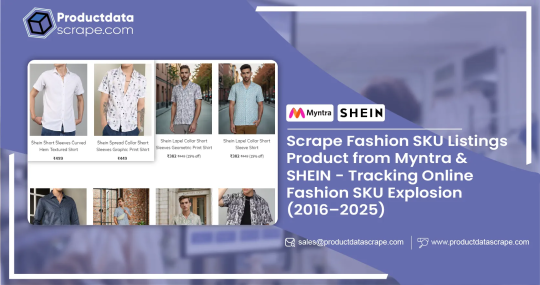
Introduction
The online fashion market has witnessed a dramatic surge in SKUs (Stock Keeping Units) over the past decade. As major players like Myntra and SHEIN expand their product lines to cater to rapidly changing consumer demands, brands and analysts alike need robust data extraction strategies to stay competitive. Scrape Fashion SKU Listings Product from Myntra & SHEIN is now crucial for brands, resellers, and researchers who want to understand trends, monitor pricing shifts, and track new arrivals in real-time.
For context, Myntra’s SKU count rose from approximately 30,000 in 2016 to well over 1 million unique listings by 2025, while SHEIN’s explosive inventory strategy took their SKU count from around 50,000 to nearly 1.5 million in the same period. This SKU explosion represents both an opportunity and a challenge: more choices mean more data to analyze and more insights to gain.
In this blog, we break down how to Web Scraping Fashion SKUs from Myntra & SHEIN, key methods for Extracting Fashion SKU Listings Product Data from Myntra, leveraging a SHEIN Fashion Product SKU Scraper, and using advanced tools for Extract Real-Time Fashion SKU Tracking For Myntra & SHEIN. We’ll also show you practical stats, datasets, and benefits of partnering with a reliable Product Data Scrape provider.
Why You Need to Scrape Fashion SKU Listings Product from Myntra & SHEIN?
The fashion e-commerce boom is rewriting how brands manage inventory, pricing, and promotions. As platforms like Myntra and SHEIN aggressively expand their catalogs, businesses must keep pace with this SKU avalanche. Scrape Fashion SKU Listings Product from Myntra & SHEIN is no longer just a nice-to-have — it’s a must for fashion brands, research agencies, and marketplace sellers who want to stay ahead of the curve.
Today’s shoppers demand fresh styles and endless options. In 2016, Myntra offered about 30,000 SKUs. By 2025, that figure is projected to reach over 1.2 million, driven by micro-segmentation, regional collections, and brand collaborations. SHEIN’s model is even more aggressive: from 50,000 SKUs in 2016 to an estimated 1.5 million by 2025, it thrives on fast churn, short production cycles, and rapid launch of new collections.
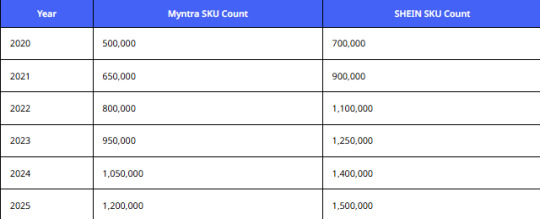
This staggering SKU growth means more choices for buyers — but for sellers, it means fierce competition, faster sell-through cycles, and the need for real-time data. By using Web Scraping Fashion SKUs from Myntra & SHEIN, you can keep tabs on which products are trending, which ones are discounted, and which categories are getting saturated.
Access to fresh data also improves marketing ROI. Brands that Extract Popular E-Commerce Website Data can benchmark against competitors, plan smarter ad spend, and tweak pricing dynamically. Staying blind to this SKU explosion is no longer an option — real-time Product Data Scrape is the new edge.
How to Extract Fashion SKU Listings Product Data from Myntra?
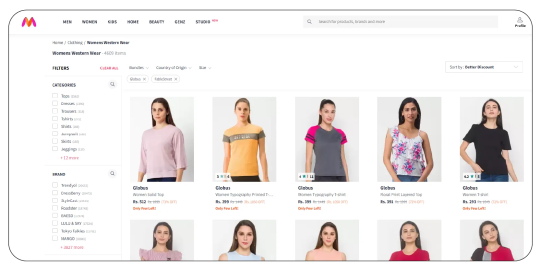
Myntra, owned by Flipkart, is India’s largest online fashion retailer. With thousands of brands and regular flash sales, Myntra’s listings are a goldmine for fashion intelligence — if you know how to mine it. To stay relevant, sellers and analysts should learn how to Extract Fashion SKU Listings Product Data from Myntra in a scalable way.
Each product listing on Myntra holds valuable details: titles, descriptions, SKUs, size options, colorways, pricing history, discounts, stock status, and customer ratings. Building a structured Myntra Product and Review Dataset lets you slice this data for trend analysis, competitor mapping, and dynamic repricing.
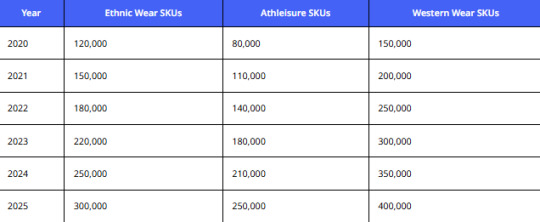
The table shows how categories like ethnic wear and athleisure are expanding rapidly. An exporter or D2C brand can’t afford to guess which trends will sell — you need to Extract Myntra E-Commerce Product Data systematically. Using automated tools for Web Scraping for Fashion & Apparel Data means you don’t waste time with manual checks or outdated data.
Combine this with user review scraping to get sentiment insights: are buyers complaining about sizing? Do they mention fabric quality? These micro-insights are game changers for product design and inventory planning.
With clean Myntra datasets, you can build real-time dashboards that help your team react faster than the competition. That’s how smart players win in India’s crowded online fashion game.
Unlock growth: Extract Fashion SKU Listings Product Data from Myntra today and power smarter pricing, trends, and inventory decisions.
Benefits of Using a SHEIN Fashion Product SKU Scraper
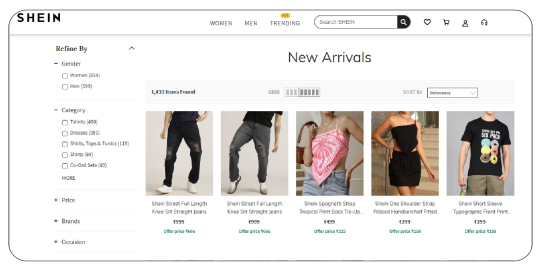
No brand does hyper-fast fashion at scale like SHEIN. The Chinese powerhouse has mastered churning thousands of new products every week, dropping limited batches, and pulling listings that don’t sell — all in real-time. This model demands constant monitoring. A SHEIN Fashion Product SKU Scraper gives you this edge by turning chaos into clean, actionable data.
SHEIN’s churn rate is among the highest in the industry. From 2020–2025, the average SKU churn grew from 45% to an estimated 65% per year. That means if you check today and come back next month, up to two-thirds of listings could be gone or replaced.
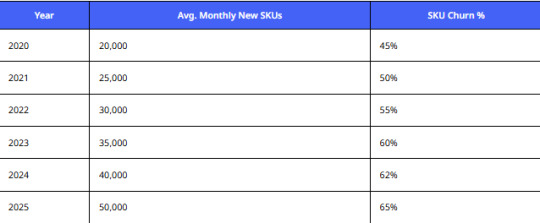
Using Web Scraping SHEIN E-Commerce Product Data means you can spot hot sellers before they hit peak demand. Dropshippers and marketplace sellers especially benefit from fast signals: which categories are booming, which products to replicate, and when to pivot.
A SHEIN Fashion Product SKU Scraper also helps you monitor flash sales and discount timings — crucial for pricing strategies. When you Extract Real-Time Fashion SKU Tracking For Myntra & SHEIN, you’re not playing catch-up. You’re making data-backed choices that match SHEIN’s speed.
For global brands, scraping SHEIN can also reveal design trends and consumer preferences across different geographies. Combined with other Ecommerce Data Scraping Services, this data helps you adapt catalog size, design, and pricing for maximum market fit.
Real-Time Fashion SKU Tracking For Myntra & SHEIN
Fast fashion isn’t just about volume — it’s about speed. Once, quarterly updates were enough. Now, brands must react daily. Using Extract Real-Time Fashion SKU Tracking For Myntra & SHEIN gives you the ability to monitor listings, stock status, price drops, and new launches as they happen.
SHEIN and Myntra combined account for millions of SKUs with rapid churn. For instance, in 2020, brands needed an average of two weeks to adjust pricing to competitor moves. By 2025, leading sellers using Web Scraping Fashion SKUs from Myntra & SHEIN reduce this lag to under 24 hours.
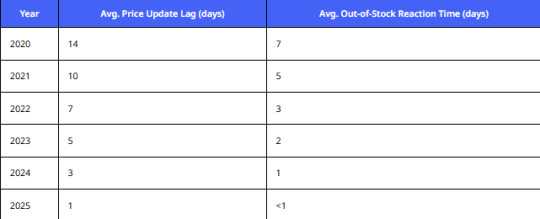
That means if a top competitor drops prices or restocks trending SKUs, your team can instantly match or beat the offer. This live feed is only possible when you Scrape Fashion SKU Listings Product from Myntra & SHEIN with an automated pipeline.
With Web Scraping E-commerce Websites, smart brands feed this SKU and price data into dashboards that integrate with ad platforms, marketplaces, and ERP systems. This level of automation boosts margins, prevents dead stock, and supports dynamic repricing at scale.
In short, real-time SKU tracking flips the script. Instead of reacting to the market, you shape it — by leveraging E-commerce Product Prices Dataset and live updates for every category, every day.
Extract Fashion & Apparel Data for Smarter Merchandising
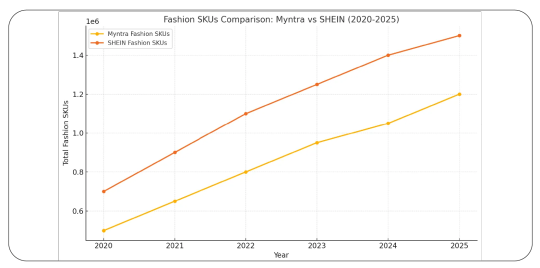
Fashion buyers and merchandisers depend on accurate, broad datasets to decide which styles deserve bigger orders, which colors to push, and when to launch promotions. To win in this game, teams Extract Fashion & Apparel Data at scale and turn insights into profit.
In India alone, categories like women’s dresses, ethnic wear, and activewear have doubled SKU counts from 2020–2025 on Myntra. Meanwhile, SHEIN’s global micro-collection strategy ensures 5,000+ new SKUs hit the market every day.
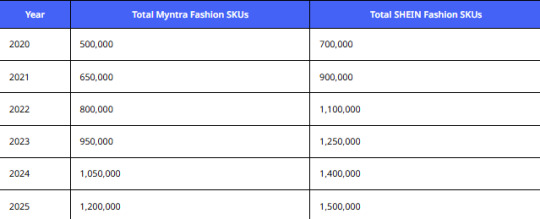
By applying Web Scraping for Fashion & Apparel Data, you can segment listings by style, price band, brand, and region. Want to know what price point sells best in Tier-2 cities? Or which fabric blends get the highest ratings? A clean feed from your Product Data Scrape partner unlocks these insights.
For private labels or new sellers, scraped data highlights underserved niches. See a gap in plus-size activewear or modest fashion? Fill it before your competitors do — with facts, not hunches.
This is where good Ecommerce Data Scraping Services pay off: you’re not pulling random numbers — you’re building a custom Myntra Product and Review Dataset or SHEIN Fashion Product SKU Scraper pipeline that’s tailored to your category.
The result? Smarter buying, lower dead stock, and bigger margins.
Extract Fashion & Apparel Data now to boost your merchandising strategy with real-time trends, pricing insights, and SKU-level intelligence.
Extract Popular E-Commerce Website Data at Scale
While Myntra and SHEIN dominate the online fashion SKU game, smart sellers don’t stop there. Broader Extract Popular E-Commerce Website Data initiatives help you map trends across platforms and verticals.
Many brands selling on Myntra also list on Ajio, Amazon Fashion, or niche marketplaces. Pulling SKU, price, and review data from all these sources using Web Scraping E-commerce Websites gives you the big picture: which channels push volume? Where are your competitors investing in ads and discounts? Which SKUs perform best across regions?

Cross-platform scraping helps you adjust your merchandising. Maybe your bestsellers on Myntra flop on Ajio — why? What can you learn from product reviews? With data from Web Scraping SHEIN E-Commerce Product Data , you can test new price bands or localize stock based on real-world trends.
This cross-platform approach strengthens your entire data strategy. Combined with your E-commerce Product Prices Dataset , you can design geo-targeted campaigns, competitive pricing, and better promotions.
The future of fashion is connected — and your Product Data Scrape strategy is what ties it all together.
Why Choose Product Data Scrape?
Choosing the right partner for Scrape Fashion SKU Listings Product from Myntra & SHEIN is the difference between patchy data and a powerful, reliable feed. The right provider will offer:
High-frequency updates for accurate tracking
Scalable scrapers for millions of SKUs
Clean, structured datasets with historical depth
Integration with BI dashboards or APIs
A strong Product Data Scrape partner doesn’t just deliver raw data — they empower your merchandising, pricing, and marketing teams to act on it.
Conclusion
The global fashion SKU race isn’t slowing down. Staying ahead means investing in robust tools to Scrape Fashion SKU Listings Product from Myntra & SHEIN and transform raw data into smarter, faster decisions. Start leveraging reliable E-commerce Data Scraping Services today to unlock the next level of fashion intelligence.
Source >>https://www.productdatascrape.com/scrape-fashion-sku-listings-product-myntra-shein.php
#ScrapeFashionSKUListingsProductFromMyntraAndSHEIN#WebScrapingFashionSKUsFromMyntraAndSHEIN#ExtractFashionSKUListingsProductDataFromMyntra#ExtractRealTimeFashionSKUTrackingForMyntraAndSHEIN#WebScrapingSHEINECommerceProductData#ExtractFashionAndApparelData
0 notes
Text
How Quick Commerce Apps Use Web Scraping for Competitive Pricing
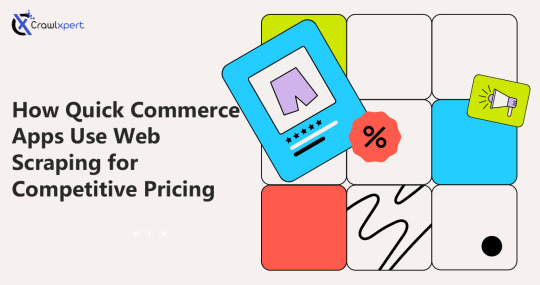
Introduction
In the rapidly changing market of quick commerce, competition is fierce for businesses to win customer loyalty and subsequently market share. Pricing is undoubtedly one of the key factors influencing consumer decisions in the instant delivery arena. To remain ahead of the game, these quick commerce apps use perhaps the most powerful tactic: web scraping for the collection, analysis, and dynamic alteration of pricing strategies.
This blog discusses how web scraping quick commerce applications enable businesses in real-time price information extraction, evaluating competitor prices, and institute solid pricing strategies. We will also consider the methods, the challenges along the way, and the best practices for quick commerce app data extraction.
Understanding Quick Commerce and Its Competitive Landscape
Quick commerce (Q-commerce) is an advanced e-commerce model that focuses on ultra-fast deliveries, typically within 10 to 30 minutes. Leading players such as Instacart, Gopuff, Getir, Zapp, and Blinkit have redefined customer expectations by offering instant grocery and essential item deliveries.
Given the high competition and dynamic pricing models in the industry, quick commerce apps data scraper solutions are increasingly being used to gain pricing intelligence and make real-time adjustments.
Why Quick Commerce Apps Use Web Scraping for Competitive Pricing
1. Real-Time Price Monitoring
Quick commerce companies continuously scrape competitor websites to ensure their pricing remains competitive.
Scraping quick commerce apps data enables businesses to track price changes and adjust accordingly.
2. Dynamic Pricing Optimization
Real-time data extraction helps companies implement automated price adjustments based on competitor pricing trends.
AI-driven algorithms use scraped pricing data to set optimal pricing strategies.
3. Competitor Benchmarking
Quick commerce apps data collections offer insights into competitor pricing, discounts, and promotions.
Businesses can assess market trends and consumer purchasing behavior to position themselves strategically.
4. Consumer Behavior Analysis
Price sensitivity varies among different customer demographics.
Quick commerce apps data extractor solutions analyze historical price trends to identify customer behavior patterns.
5. Stock and Availability Insights
Web scraping also helps track product availability across various competitors.
Businesses can adjust their inventory and pricing strategies based on demand trends.
How Web Scraping Works for Quick Commerce Pricing Intelligence
1. Identifying Target Quick Commerce Apps
Before implementing a quick commerce apps data scraper, businesses must identify the top competitors in their industry. Some popular quick commerce apps include:
Instacart – Grocery delivery from multiple retailers
Gopuff – Instant delivery of everyday essentials
Getir – On-demand grocery delivery
Zapp – 24/7 convenience store at your doorstep
Blinkit – Ultra-fast grocery delivery in India
2. Data Points Extracted for Competitive Pricing
Web scraping quick commerce apps involves extracting crucial pricing-related data points such as:
Product Name
Brand and Category
Competitor Pricing
Discounts and Promotions
Stock Availability
Delivery Fees and Charges
3. Web Scraping Tools and Technologies Used
To perform efficient quick commerce apps data extraction, businesses use:
Scrapy – A Python-based web scraping framework.
Selenium – Automates browser-based scraping for dynamic pages.
BeautifulSoup – Extracts structured data from HTML pages.
Proxies & Rotating IPs – Prevents blocking while scraping large datasets.
4. Data Cleaning and Processing
Once extracted, quick commerce apps data collections are structured into organized formats such as JSON, CSV, or databases for analysis.
5. Implementing Pricing Strategies
AI-based algorithms analyze the scraped data to:
Adjust prices dynamically based on real-time competitor data.
Optimize discount offerings.
Enhance consumer engagement through personalized pricing strategies.
6. Automated Price Adjustment
Businesses integrate scraped data into pricing algorithms to dynamically modify their product prices.
Price adjustments can be triggered based on competitor movements, stock levels, or peak demand periods.
7. Predictive Pricing Models
Machine learning models process scraped pricing data to forecast future pricing trends.
Retailers can use predictive analytics to set optimal pricing strategies before competitors adjust their prices.
8. Custom Alerts and Notifications
Businesses set up alerts when competitors change pricing structures, allowing real-time responses.
Notifications can be automated through dashboard integrations for instant decision-making.
Challenges in Scraping Quick Commerce Apps Data
1. Anti-Scraping Mechanisms
Many quick commerce platforms use CAPTCHAs, IP blocking, and bot detection to prevent automated scraping.
Solutions: Use rotating proxies, user-agent rotation, and headless browsing to bypass restrictions.
2. Frequent Website Structure Changes
Quick commerce apps regularly update their UI, requiring frequent updates to web scrapers.
Solutions: Implement dynamic XPath selectors and use AI-powered adaptive scrapers.
3. Dynamic Content Loading
Many platforms use JavaScript-rendered content, making scraping more challenging.
Solutions: Use Selenium or Puppeteer for headless browser interactions.
4. Legal and Ethical Considerations
Businesses must comply with data privacy laws and terms of service.
Solutions: Focus on publicly available data and respect robots.txt policies.
Best Practices for Web Scraping Quick Commerce Apps
Use Headless Browsing – To navigate JavaScript-heavy content efficiently.
Leverage API Access Where Possible – Some quick commerce apps offer APIs for structured data extraction.
Monitor and Adapt to Changes – Regularly update scrapers to adapt to changing website structures.
Ensure Data Accuracy and Deduplication – Implement validation checks to avoid redundant data entries.
Utilize Cloud-Based Scraping Services – To handle large-scale scraping tasks more efficiently.
Future of Competitive Pricing with Web Scraping
1. AI-Driven Pricing Algorithms
AI and machine learning will play a significant role in predictive pricing based on web-scraped competitor data.
2. Integration with Business Intelligence Tools
Web-scraped data will be seamlessly integrated with BI platforms for real-time pricing analysis.
3. Blockchain for Transparent Pricing
Blockchain technology may improve data transparency and reliability in pricing comparisons.
4. Automated Decision-Making Systems
Businesses will automate price adjustments using real-time scraped data and dynamic pricing models.
Conclusion
Web scraping from instant commerce platforms has opened up new avenues for pricing in today's intense competition in e-commerce. The scraped data of instant commerce applications become indeed instrumental for organizations to track their competitors, modify their pricing strategies in real-time, and make their customer engagement even better. As the name implies, in-depth pricing intelligence will be revolutionized by data, and leaving this exact technological edge will be one of the requisites for sustained success in the market.
Know More : https://www.crawlxpert.com/blog/quick-commerce-apps-use-web-scraping
#WebScrapingCompetitivePricing#WebScrapingQuickCommerce#ScrapingQuickCommerceAppsData#ScrapeQuickCommerceAppsData
0 notes
Text
Unlocking Customer Insights: The Complete Guide to Scraping Blinkit Reviews Data
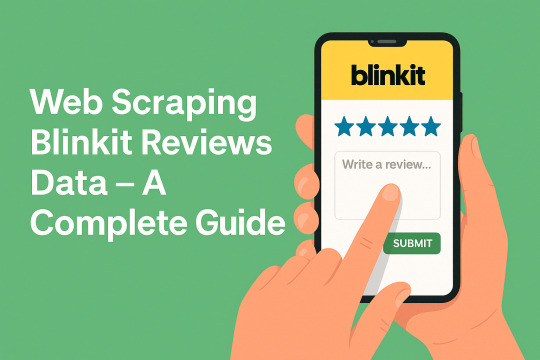
In today’s fast-paced digital economy, understanding your customer is everything. Blinkit, one of India’s top hyperlocal delivery apps, handles millions of grocery and essential deliveries daily. And behind every order lies a customer review full of insights. So, how can businesses tap into this goldmine of customer sentiment?
Simple: Web scraping Blinkit reviews data.
This guide explores how to systematically collect and analyze customer reviews using a Blinkit Reviews Scraper. From discovering market trends to improving products and customer service, you’ll see why review data is one of the smartest ways to sharpen your competitive edge.
Why Blinkit Reviews Matter
Formerly known as Grofers, Blinkit is a household name in rapid delivery. With thousands of SKUs and a large urban user base, Blinkit’s reviews offer:
Customer Sentiment: Understand real-time satisfaction levels, complaints, and delight factors.
Product Insights: Find out what users love or dislike about specific products.
Market Trends: Monitor new demands and seasonality from organic feedback.
Localized Preferences: Discover how customer experiences vary across cities and neighborhoods.
These reviews aren’t just opinions—they’re actionable data.
What is Web Scraping?
Web scraping is a method of automatically collecting data from websites. A Blinkit Reviews Scraper can extract structured insights like:
Star ratings
Review comments
Product references
Timestamps
This process is scalable, accurate, and faster than manual research. With tools like Datazivot’s Blinkit Reviews Data Extractor, businesses can turn raw text into meaningful trends in no time.
Powerful Use Cases for Blinkit Reviews Scraping
Let’s break down how you can use this data:
Product Development
Spot recurring issues (e.g., broken packaging, stale products)
Track positive mentions to replicate success across SKUs
Pricing Strategy
Use sentiment analysis to see if users feel products are worth their price
Competitor Benchmarking
Compare reviews of your products vs. competitor listings
Inventory Management
Predict demand spikes based on positive or trending reviews
Localized Campaigns
Customize your marketing based on what specific neighborhoods love most
Ethical and Legal Considerations
Before scraping:
Check Terms of Service: Always review Blinkit’s policies
Respect robots.txt: Only scrape data allowed by the website
Throttle Requests: Avoid being flagged or blocked
Use scraped data for internal insights, not redistribution. Ethical scraping builds trust and sustainability.
Technical Snapshot: Building a Blinkit Reviews Scraper
To effectively scrape Blinkit reviews, your tool should:
Handle JavaScript-heavy content
Navigate pagination
Extract structured data (ratings, comments, timestamps)
Simulate real-user behavior using headers/cookies
Store data in CSV, JSON, or databases
Popular tools:
BeautifulSoup + Requests (Python): Best for static content
Selenium/Puppeteer: Great for dynamic content
Scrapy: Excellent for scalable projects
Clean, Analyze, and Visualize the Data
Once scraped, clean the data:
Remove duplicates
Normalize text (e.g., lowercase, strip punctuation)
Translate reviews if multilingual
Then analyze:
Sentiment Scores (using NLTK or TextBlob)
Trend Graphs (using Pandas/Matplotlib)
Word Clouds (to visualize common issues or praise)
Real-World Applications
Here’s how brands are already using Blinkit review data:
Brand Reputation Monitoring: Real-time customer sentiment tracking
AI & ML Training: Feeding labeled review data into models
Campaign Optimization: Using reviews to fine-tune ad messaging
Customer Support Planning: Identify and fix issues before they escalate
Overcoming Scraping Challenges
Dynamic Pages: Use headless browsers like Puppeteer
IP Blocking: Rotate proxies and use user-agent headers
Captcha: Build fallback logic
Partnering with experts like Datazivot ensures you get clean, accurate, and compliant data.
Why Choose Datazivot?
We specialize in scalable and ethical web scraping solutions tailored to your goals. Whether you need one-time extraction or live data feeds, our Blinkit Reviews Data Scraper is designed for accuracy and speed.
Plug-and-play API solutions
Custom dashboards for insights
End-to-end support from data collection to visualization
Conclusion
Customer reviews are no longer just feedback—they’re data-driven blueprints for business growth. With Blinkit Reviews Data Scraping, you can unlock customer preferences, track trends, and outmaneuver the competition.
Start turning reviews into revenue.
🚀 Explore Datazivot's Blinkit Reviews Scraper and transform customer feedback into actionable insights.
Follow us on LinkedIn for more content on web scraping, data strategies, and eCommerce intelligence.
#startup#founder#branding#artists on tumblr#Web Scraping Blinkit Reviews Data#Blinkit Reviews Data Scraping#Scrape Blinkit Reviews Data#Blinkit Reviews Data Extractor#Blinkit Reviews Scraper
0 notes
Text
Understanding Web Scraping: Techniques, Ethics & Professional Guidance

Web scraping is a widely-used method for automatically extracting information from websites. It allows users to programmatically gather large volumes of data without manual copying and pasting. This technology has become essential for professionals in fields like market research, journalism, and e-commerce. In this blog, we’ll explore what web scraping is, how it works, and why practicing it ethically matters—along with how partnering with experts in web development can enhance your data strategy.
What Is Web Scraping?
At its core, web scraping is a digital technique that simulates human browsing to extract useful information from websites. It involves writing scripts that send requests to web pages, parse the HTML code, and organize extracted content—such as prices, reviews, or contact info—into structured formats like spreadsheets or databases.
Many developers choose languages like Python for web scraping due to its clean syntax and powerful libraries like Beautiful Soup and Scrapy. These tools make it easier to navigate and extract data from complex websites efficiently.
Common Applications of Web Scraping
Web scraping serves a wide variety of purposes across different industries:
Market Research: Businesses collect consumer feedback and competitor pricing to understand market trends.
E-commerce Monitoring: Online stores track product availability and prices across multiple platforms.
News & Journalism: Reporters gather public data or breaking information to support their stories.
Academic Research: Analysts compile datasets for large-scale studies or surveys.
By leveraging these insights, companies can fine-tune their strategies and stay ahead of the competition.
Why Ethical Web Scraping Matters
While web scraping can be incredibly useful, it must be done responsibly. Key ethical considerations include:
Respect for Consent: Many websites specify in their terms of service whether scraping is allowed. Ignoring these terms may result in legal issues or damage to your reputation.
Robots.txt Compliance: Most websites use a file called robots.txt to control which parts of their site are accessible to bots. Ethical scrapers always check and follow these rules.
Data Usage Responsibility: Scraped data must be handled with care, especially if it contains personal or sensitive information. It should never be exposed or misused.
Maintaining an ethical stance helps preserve trust across the digital ecosystem and ensures long-term viability of web scraping as a business tool.
How to Practice Ethical Web Scraping
To make your web scraping efforts both effective and ethical, consider the following best practices:
Review Website Policies: Always check the site’s terms of service and robots.txt file before scraping.
Limit Request Frequency: Sending too many requests at once can overload a website’s server. Adding delays between requests is a respectful practice.
Anonymize Sensitive Data: If your project involves sharing scraped data, make sure it does not expose personal information.
Use Reliable Tools and Secure Platforms: Implement scraping on well-developed systems that adhere to best practices in coding and data security.
Get Professional Help with Ethical Web Development
While scraping tools are powerful, integrating them into a secure and compliant workflow requires professional expertise. That’s where a reliable partner like Dzinepixel comes in. As a leading web development company in India, Dzinepixel has worked with a wide range of businesses to create customized, secure, and ethical digital solutions.
Whether you need assistance building an efficient scraping tool or a full-fledged data dashboard, their expert developers can help you:
Create scalable and secure backend systems
Ensure compliance with data protection laws
Develop user-friendly interfaces for visualizing scraped data
Build APIs and data integration pipelines
By relying on an experienced web development team, you can streamline your scraping workflows while avoiding legal or technical pitfalls.
Final Thoughts
Web scraping is a valuable technique that helps individuals and organizations access critical data quickly and efficiently. However, it’s essential to approach it with caution and ethics. By understanding how scraping works, respecting website policies, and managing data responsibly, you ensure long-term success and sustainability.
If you're considering a web scraping project, or if you want to build a robust and secure platform for your business, explore the services offered by Dzinepixel’s web development team. Their expertise in building high-performance digital systems can give you a competitive edge while staying compliant with all ethical and legal standards.
Start small—review a website’s policies, test your scraping tool responsibly, or consult a professional. The right foundation today ensures scalable, secure success tomorrow.
#best web development agencies india#website design and development company in india#website development company in india#web design company india#website designing company in india#digital marketing agency india
0 notes
Text
Understanding Web Scraping: Techniques, Ethics & Professional Guidance

Web scraping is a widely-used method for automatically extracting information from websites. It allows users to programmatically gather large volumes of data without manual copying and pasting. This technology has become essential for professionals in fields like market research, journalism, and e-commerce. In this blog, we’ll explore what web scraping is, how it works, and why practicing it ethically matters—along with how partnering with experts in web development can enhance your data strategy.
What Is Web Scraping?
At its core, web scraping is a digital technique that simulates human browsing to extract useful information from websites. It involves writing scripts that send requests to web pages, parse the HTML code, and organize extracted content—such as prices, reviews, or contact info—into structured formats like spreadsheets or databases.
Many developers choose languages like Python for web scraping due to its clean syntax and powerful libraries like Beautiful Soup and Scrapy. These tools make it easier to navigate and extract data from complex websites efficiently.
Common Applications of Web Scraping
Web scraping serves a wide variety of purposes across different industries:
Market Research: Businesses collect consumer feedback and competitor pricing to understand market trends.
E-commerce Monitoring: Online stores track product availability and prices across multiple platforms.
News & Journalism: Reporters gather public data or breaking information to support their stories.
Academic Research: Analysts compile datasets for large-scale studies or surveys.
By leveraging these insights, companies can fine-tune their strategies and stay ahead of the competition.
Why Ethical Web Scraping Matters
While web scraping can be incredibly useful, it must be done responsibly. Key ethical considerations include:
Respect for Consent: Many websites specify in their terms of service whether scraping is allowed. Ignoring these terms may result in legal issues or damage to your reputation.
Robots.txt Compliance: Most websites use a file called robots.txt to control which parts of their site are accessible to bots. Ethical scrapers always check and follow these rules.
Data Usage Responsibility: Scraped data must be handled with care, especially if it contains personal or sensitive information. It should never be exposed or misused.
Maintaining an ethical stance helps preserve trust across the digital ecosystem and ensures long-term viability of web scraping as a business tool.
How to Practice Ethical Web Scraping
To make your web scraping efforts both effective and ethical, consider the following best practices:
Review Website Policies: Always check the site’s terms of service and robots.txt file before scraping.
Limit Request Frequency: Sending too many requests at once can overload a website’s server. Adding delays between requests is a respectful practice.
Anonymize Sensitive Data: If your project involves sharing scraped data, make sure it does not expose personal information.
Use Reliable Tools and Secure Platforms: Implement scraping on well-developed systems that adhere to best practices in coding and data security.
Get Professional Help with Ethical Web Development
While scraping tools are powerful, integrating them into a secure and compliant workflow requires professional expertise. That’s where a reliable partner like Dzinepixel comes in. As a leading web development company in India, Dzinepixel has worked with a wide range of businesses to create customized, secure, and ethical digital solutions.
Whether you need assistance building an efficient scraping tool or a full-fledged data dashboard, their expert developers can help you:
Create scalable and secure backend systems
Ensure compliance with data protection laws
Develop user-friendly interfaces for visualizing scraped data
Build APIs and data integration pipelines
By relying on an experienced web development team, you can streamline your scraping workflows while avoiding legal or technical pitfalls.
Final Thoughts
Web scraping is a valuable technique that helps individuals and organizations access critical data quickly and efficiently. However, it’s essential to approach it with caution and ethics. By understanding how scraping works, respecting website policies, and managing data responsibly, you ensure long-term success and sustainability.
If you're considering a web scraping project, or if you want to build a robust and secure platform for your business, explore the services offered by Dzinepixel’s web development team. Their expertise in building high-performance digital systems can give you a competitive edge while staying compliant with all ethical and legal standards.
Start small—review a website’s policies, test your scraping tool responsibly, or consult a professional. The right foundation today ensures scalable, secure success tomorrow.
#website development company in india#web design company india#website designing company in india#best web development agencies india#digital marketing agency india#online reputation management companies in india
0 notes
Text
How to Extract Airbnb Hotels Data Using Airbnb APIs in India
Introduction
Accessing Airbnb APIs for the Indian market provides a competitive edge for travel platforms, agencies, and businesses that require real-time, accurate data from one of the world’s largest accommodation platforms. Gaining access to the Airbnb API allows businesses to automate extracting key information such as listing prices, availability, and messaging between hosts and guests, which can dramatically enhance service offerings and streamline operations.
With India being a growing travel hub, access to data via Airbnb Hotel Data Scraping Solutions enables businesses to optimize pricing strategies, improve customer experience, and ensure that their inventory is always accurate. In this blog, we will explore the significant functionalities available through Airbnb Web Scraping API for India Market and how businesses can benefit from using APIs to extract Airbnb data with API for India Market.
Importance of Gaining Access to Airbnb APIs
For businesses operating in the travel and hospitality industry, having access to updated and reliable data is essential to remain competitive. Whether understanding pricing trends or managing room availability, Airbnb’s vast data repository provides a wealth of information. Through Airbnb Hotel Listing Data Scraper tools, businesses can retrieve real-time data for the Indian market to deliver a more comprehensive user experience.
APIs serve as a bridge between the platform and travel businesses. Whether you are a price comparison site, a travel agency, or a booking platform, having access to data through an API allows you to make more informed business decisions, offer competitive rates, and improve overall customer satisfaction. The ability to scrape hotel prices & listings ensures that businesses can act on the most up-to-date information.
Key Airbnb API Functionalities for the India Market
One of the most valuable aspects of gaining access to Airbnb’s API is the ability to extract Airbnb hotels data, including pricing information. This data can help travel platforms and agencies monitor listing prices across various regions of India, allowing for detailed analysis and comparison.
Using the Airbnb Hotel Pricing & Listing Data Scraper, companies can track price trends, including seasonal variations and changes in response to local events or festivals. By tracking Airbnb hotel pricing using real-time data from the API, businesses can better align their pricing strategies with market demands. For instance, if you are a travel agency, you could recommend the best deals to your clients based on live data, providing them with cost savings and updated availability.
Moreover, pricing data can help in analyzing competitors. Businesses using web scraping Airbnb data can compare their pricing to other platforms, ensuring they offer competitive rates. Extracting pricing information allows travel companies to adjust pricing dynamically and make data-driven decisions about promotions and discounts. The Airbnb Hotel Price Data Collection functionality is vital for anyone looking to provide accurate price comparisons and maximize revenue opportunities.
Calendar data is another key component for businesses using Airbnb’s API. By accessing this functionality through web scraping Airbnb data, travel platforms can retrieve booking availability in real-time for Airbnb properties in India. This allows for the automation of listing management, ensuring that only available properties are shown to potential customers.
The ability to extract real-time data scraping API information from the Airbnb platform ensures that businesses remain in sync with the platform’s availability. Travel booking platforms can use Airbnb hotel data scraping solutions to update their inventory automatically, reducing the risk of double bookings or offering unavailable listings to customers.
For instance, if a customer is looking for accommodation in popular tourist destinations such as Goa, Kerala, or Rajasthan, the Airbnb Web Scraping API for India Market can help businesses check current availability and offer customers the best options. This eliminates the need for manual updates, saves time, and ensures that customers can always rely on accurate booking information.
Moreover, businesses that provide package travel services can use this data to bundle accommodations with flights or activities, ensuring their customers have a complete travel experience. By leveraging the Airbnb hotel listing data scraper tools, travel businesses can automate this process, offering customers and operational teams convenience.
Another crucial feature of the Airbnb Hotels Data Scraping API is access to the messaging webhook, which provides notifications on communications between hosts and guests. This feature lets businesses stay on top of important updates, helping them monitor or automate customer communication.
The message webhook functionality is handy for businesses that provide concierge services or manage many Airbnb properties. With Airbnb hotel pricing & listing data scraper solutions, travel platforms can receive real-time updates about communication, ensuring they stay informed about guest queries, bookings, and potential issues that may arise.
Businesses can enhance customer service efficiency by integrating the web data extracting APIs related to messaging. For example, customer support teams can be alerted to important guest messages, ensuring timely responses tailored to customer needs. This adds value to the customer experience, creating stronger relationships between travel companies and their clients.
Benefits of Airbnb APIs for the India Market
There are numerous advantages to gaining access to Airbnb Hotel Data Scraping Solutions in the Indian market. With tourism in India being one of the largest industries, travel companies must stay competitive, offering local and international travelers the most up-to-date information and accommodation pricing. Here are some of the key benefits of leveraging web scraping services and APIs for the Indian market:
Real-Time Data: Access to real-time data scraping API allows businesses to offer immediate, up-to-date information to customers. Whether pricing, availability, or communication, automation ensures your business stays ahead.
Scalability: For businesses that handle extensive listings, scraping Airbnb hotels data through APIs ensures that the process is scalable, allowing thousands of listings to be managed with minimal effort.
Improved Customer Experience: Travel platforms can use web scraping API services to offer more accurate and timely information to customers, leading to higher satisfaction and better reviews.
Optimized Pricing: The ability to extract data using API allows travel companies to adjust their pricing strategies based on market trends, increasing profitability and market share.
Automation: Manually managing listings, pricing, and availability is time-consuming. Businesses can automate these tasks by utilizing Travel Scraping API tools, improving operational efficiency.
Competitive Edge: Having access to reliable data means travel companies can make data-driven decisions, offering better deals and services than competitors who do not use API-driven solutions.
Conclusion
Gaining access to Airbnb APIs for the Indian market is essential for travel businesses that want to remain competitive in today’s fast-paced environment. By using Airbnb listing data scraper tools, companies can automate extracting key information such as pricing, availability, and guest-host communication. This data can enhance user experiences, optimize business strategies, and stay ahead in a growing market.
For Travel aggregators looking to Scrape Airbnb Hotel Room Pricing And Reviews Data, the benefits are clear—real-time information, scalability, and automation are just some ways that integrating APIs can improve your service offerings. By leveraging the Airbnb Hotel Price Data Collection feature and ensuring up-to-date listings, businesses can provide better experiences to both local and international travelers.
Ready to transform your travel platform? Travel Scrape offers industry-leading Travel Data Scraping With API solutions to scrape mobile travel app data, track Airbnb hotel room pricing and reviews, and provide accurate insights into your market.
Contact Travel Scrape today to access web scraping hotel data and unlock the full potential of Airbnb APIs in India!
Source : https://www.travelscrape.com/extract-airbnb-hotels-data-using-airbnb-api-in-india.php
#ExtractAirbnbHotelsData#WebScrapingAirbnbData#AirbnbHotelListingDataScraper#AirbnbHotelPricingListingDataScraper#ScrapeAirbnbHotelRoomPricingAndReviewsData#AirbnbWebScrapingAPIForIndiaMarket#ExtractAirbnbDataWithAPIForIndiaMarket
0 notes
Text
Best Web Scraping Tools to Boost Your Data Collection
Learn how to select the best web scraping tools for your needs! Our comprehensive guide covers important features, pricing, and tips to help you understand the data extraction process. Find the right tool to save time and improve your projects!
For more visit: https://outsourcebigdata.com/how-to-select-the-best-web-scraper-tool/
About AIMLEAP APISCRAPY, a division of AIMLEAP, specializes in AI-powered web scraping and automation solutions. AIMLEAP, a globally recognized technology consulting firm, holds ISO 9001:2015 and ISO/IEC 27001:2013 certifications. We provide services such as AI-enhanced data solutions, data engineering, automation, IT services, and digital marketing, and are proudly certified as a ‘Great Place to Work®’.
Our Expertise Through APISCRAPY, AIMLEAP delivers:
AI-Driven Web Scraping: Automating data extraction for real-time insights. AI-Powered Data Labeling: Accurate labeling for machine learning across industries. AI-Data-Hub: On-demand enriched datasets for data-driven decisions. Price Monitoring & Competitive Intelligence: Real-time price tracking and market analysis. Self-Serve BI Solutions: Tools to visualize and analyze business data.
Client Success & Reach Since 2012, AIMLEAP has delivered digital transformation and data solutions to 750+ global clients, including startups and large enterprises, across e-commerce, healthcare, finance, and more.
Why AIMLEAP & APISCRAPY?
Scalable & Affordable: Solutions tailored to businesses of all sizes. Advanced Technology: AI, machine learning, and cloud-based automation. Global Delivery: Centers in the USA, Canada, India, and Australia. Data Security: ISO-certified, ensuring top-tier data protection.
Key Facts:
ISO 9001:2015 and ISO/IEC 27001:2013 certified Served 750+ clients globally 11+ years of experience 98% client retention rate Great Place to Work® certified Industries We Serve:
E-commerce & Retail Healthcare & Life Sciences Financial Services Manufacturing
Contact Information:
USA: +1-30235 14656 Canada: +1 4378 370 063 India: +91 810 527 1615 Australia: +61 402 576 615 Email: [email protected]
0 notes
Text
How to Collect Real-Time Grocery Data from BigBasket and Flipkart?

Grocery delivery data scraping is a critical tool in the modern era of e-commerce, as it empowers businesses in the grocery industry to access and utilize valuable information efficiently. Through automated web scraping, businesses can gather real-time data on product availability, prices, and customer reviews from various grocery delivery platforms. This data provides insights for pricing strategies, inventory management, and understanding customer preferences, which are pivotal for staying competitive in the rapidly evolving online grocery market. With the ability to adapt and optimize operations based on scraped data, grocery delivery services can enhance efficiency, customer satisfaction, and overall business growth.
However, BigBasket and Flipkart grocery data scraping goes beyond raw data extraction; it helps businesses gain a competitive edge. Businesses can adjust their pricing strategies by analyzing pricing trends to stay competitive in the market. Streamline inventory management by monitoring product availability, ensuring customers find their needs. Furthermore, understanding customer reviews and preferences allows for a more personalized shopping experience, enhancing customer satisfaction and loyalty. In a highly dynamic and competitive sector like online grocery delivery, this data-driven approach empowers businesses to adapt swiftly, enhance operational efficiency, and ultimately flourish in an industry that demands agility and customer-centric service.
About BigBasket
BigBasket is a prominent online grocery and food delivery platform offering various products to customers across India. Established in 2011, it has become one of the country's largest and most trusted grocery e-commerce platforms. BigBasket provides a comprehensive selection of fresh produce, pantry staples, household items, and gourmet foods, all delivered to the customer's doorstep. Known for its reliability and quality, BigBasket has revolutionized the grocery shopping experience by blending convenience with a vast product range, catering to the evolving needs of modern consumers. Scrape BigBasket grocery data to unearth a goldmine of real-time insights, from pricing trends and product availability to customer preferences. This powerful tool empowers your business to outpace competitors and deliver exceptional value to your customers, thanks to the consistent collection of vital data. With a BigBasket scraper, you can stay on top of market dynamics and make informed decisions to enhance your grocery delivery services.
About Flipkart
Flipkart, founded in 2007, is a renowned Indian e-commerce company that offers a diverse range of products, from electronics and fashion to books and groceries. Initially focusing on online book sales, it has expanded into one of India's largest online marketplaces. Acquired by Walmart in 2018, Flipkart is known for its user-friendly interface, vast product selection, and well-established supply chain network. It continues to be a pioneer in the Indian e-commerce industry, providing a convenient and reliable shopping experience for millions of customers.
Scrape Flipkart grocery data to unlock the digital aisles, revealing real-time pricing, product availability, and customer sentiments. This invaluable information with Flipkart data scraper empowers businesses to optimize their offerings, align with market trends, and provide a tailored, customer-centric shopping experience, ensuring your online grocery venture thrives in an ever-evolving landscape.
Significance Of BigBasket And Flipkart Grocery Data
Recent years have witnessed a profound transformation in the grocery shopping landscape, with an increasing number of consumers embracing online platforms for the convenience of doorstep deliveries. This shift has unlocked business opportunities and intensified competition, demanding innovative strategies for success.
In the highly competitive grocery delivery sector, access to real-time data concerning pricing, product availability, and customer preferences stands as the linchpin of success. So, collect real-time grocery data from BigBasket and Flipkart to offer a treasure trove of actionable insights.
Analyzing Prices And Rivals
The strategic setting of prices is of paramount importance in the grocery delivery arena. Vigilantly monitoring competitors' pricing strategies and their promotional offers is essential for maintaining a competitive edge. Businesses can not only adapt their pricing structures but also ensure profitability.
Optimizing Delivery Routes
Efficient delivery routes are the keystone to ensuring timely and cost-effective grocery deliveries. This optimization hinges on data encompassing traffic patterns, delivery locations, and customer preferences. Such insights empower businesses to devise the most efficient routes for delivering groceries, resulting in customer satisfaction, cost savings, and a positive environmental impact.
Championing Sustainability Initiatives
In an era where environmental consciousness is on the rise, consumers are increasingly mindful of the ecological impact of their shopping habits. As businesses deliver groceries to consumers' homes, they can gather data to assess the environmental footprint of their operations. This data serves as a cornerstone for making deliveries more environmentally friendly and underscores their commitment to sustainability through reports and initiatives focused on environmental conservation. By aligning with the expectations of environmentally-conscious consumers, businesses meet evolving consumer demands and play a role in fostering a greener and more sustainable future.
Steps To Scrape BigBasket And Flipkart Grocery Delivery Data
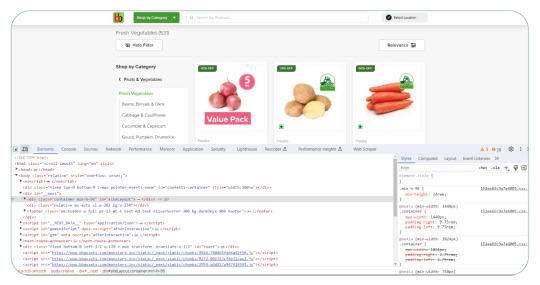
Choose the websites you want to scrape data from, in this case, BigBasket and Flipkart, as they are your target sources for grocery delivery information.
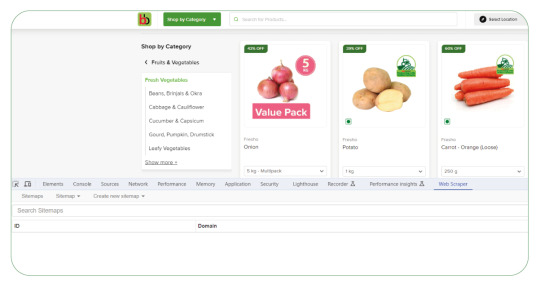
Decide on a grocery data scraper or library to use for data extraction. You can opt for tools like BeautifulSoup, Scrapy, or Selenium. Make sure to install and set up the chosen tool in your development environment.
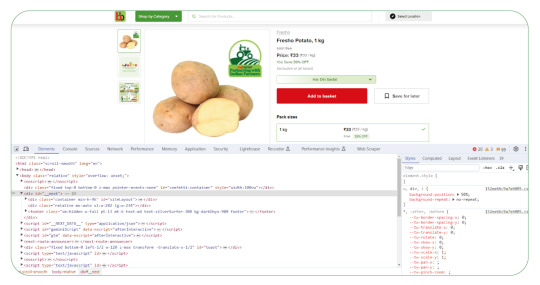
Clearly outline the specific data points you want to extract from BigBasket and Flipkart. It may include product names, prices, availability, customer reviews, and delivery information. Defining these data requirements will guide your scraping scripts.
4. Crawl the Websites:
Write web scraping scripts using the selected tool to crawl the websites. It involves navigating the web pages, locating the relevant data, and extracting it. Ensure that your scripts can handle the structure of these e-commerce websites.
5. Handle Data Extraction Challenges:
Be prepared to handle challenges that may arise during scraping, such as handling dynamic content (if any), handling CAPTCHAs, and managing website rate limits to avoid blockage.
6. Data Storage:
Store the scraped data in an organized format, such as a database, spreadsheet, or JSON file. It will make it easier to analyze and use the collected information.
7. Compliance with Ethical and Legal Standards:
Ensure your web scraping activities are conducted ethically and comply with legal standards. Respect the terms of service of BigBasket and Flipkart, avoid overloading their servers, and follow the guidelines outlined in their "robots.txt" files.
8. Data Analysis and Application:
Once you have successfully scraped the data, analyze it to gain insights into the grocery delivery market using grocery delivery data scraping services. You can use these insights to make informed business decisions, such as adjusting pricing, optimizing product offerings, and improving delivery services.
9. Regular Data Updates:
Consider implementing a mechanism for regularly updating the scraped data to keep your information current. It ensures you can always access the latest grocery delivery data from BigBasket and Flipkart.
At Product Data Scrape, we maintain the highest ethical standards in all operations, including Competitor Price Monitoring Services and Mobile App Data Scraping. With a global presence spanning multiple offices, we consistently deliver exceptional and honest services to meet the diverse needs of our valued customers.
#CollectRealTimeGroceryData#ScrapeBigBasketGroceryData#ScrapeFlipkartGroceryData#FlipkartDataScraper#GroceryDeliveryDataScraping#GroceryDataScraper#ScrapeRealTimeGroceryData
0 notes
Text
Real-Time Grocery Price Monitoring For Zepto, Blinkit & BigBasket
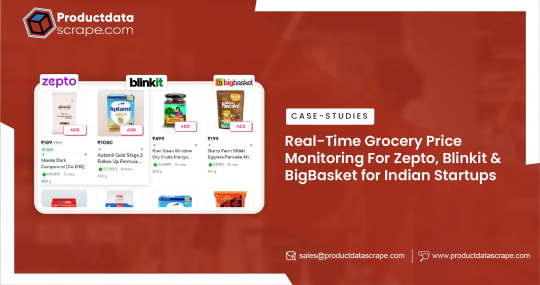
Introduction
India’s quick commerce boom has transformed how millions shop for groceries. To keep up with changing prices, offers, and hyperlocal stock availability, Indian startups are embracing Real-Time Grocery Price Monitoring For Zepto, Blinkit & BigBasket. Product Data Scrape helps these brands build competitive, real-time insights into grocery price shifts, discounts, and competitor tactics. By combining Scrape Real-Time Price Data from Zepto, Blinkit & BigBasket with robust tracking tools, startups now respond instantly to market moves and demand spikes. In this case study, discover how real-time price monitoring has powered smarter pricing, increased sales, and improved customer loyalty for India’s fastest-growing quick commerce brands.
The Client
An emerging grocery aggregator startup approached Product Data Scrape with one clear goal: outperform larger players by using reliable, granular price intelligence across India’s top grocery delivery apps. This client needed Real-Time Grocery Price Monitoring For Zepto, Blinkit & BigBasket to spot price drops, match competitor discounts, and adjust their own offers dynamically. With fierce local competition and daily pricing changes, it was no longer enough to rely on manual checks or outdated spreadsheets. The client also wanted to scale insights across multiple cities and store formats, covering essentials, fresh produce, and Gourmet Food Data. The need for a trusted partner who could deliver Real-Time Data Monitoring for Grocery Prices & Discounts led them to Product Data Scrape’s proven expertise. The client’s vision was clear: get real-time data or get left behind.
Key Challenges
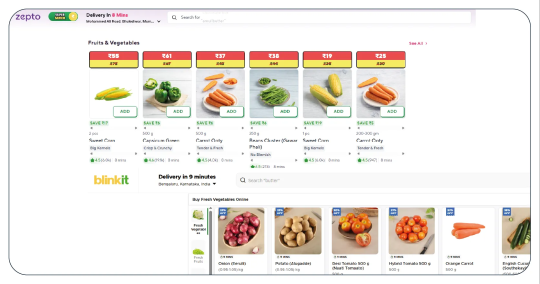
The client faced several challenges typical for India’s quick commerce and grocery tech startups. First, manual price checks on Zepto, Blinkit, and BigBasket were time-consuming and error-prone, missing daily promotions and location-specific discounts. Second, without a system to Scrape Real-Time Price Data from Zepto, Blinkit & BigBasket, they couldn’t confidently match or beat competitor offers, which led to lost customers. Third, the team struggled to handle huge volumes of SKU-level data with variations across cities, PIN codes, and product categories. They needed Real-Time Grocery Price Tracking from Zepto, Blinkit & BigBasket to feed their pricing engines and marketing tools automatically. Additionally, they lacked robust tools for Quick Commerce Grocery & FMCG Data Scraping, which meant missing insights on emerging neighborhood-level demand. They also required clean integrations with Real-Time Indian Grocery Price Scraping APIs , so their tech stack could automatically update pricing dashboards daily. Without dependable Grocery Price Monitoring Scraper For Zepto, Blinkit & BigBasket, their strategy was reactive instead of proactive. Staying competitive demanded a scalable solution to Extract Blinkit Grocery & Gourmet Food Data , Extract Bigbasket Product Data , and launch smarter promotions instantly.
Key Solutions
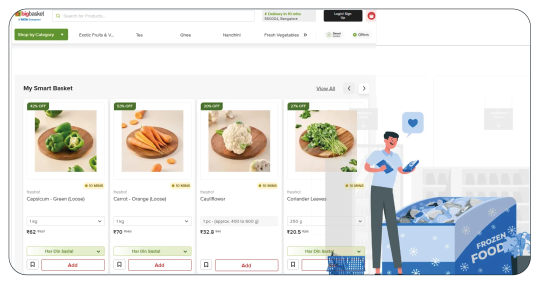
Product Data Scrape built a robust solution covering every pain point. We deployed dedicated crawlers to Scrape Real-Time Price Data from Zepto, Blinkit & BigBasket with 99% accuracy. The client gained city-level price feeds that updated hourly, fueling their dynamic pricing engine with precise SKU details and store-specific offers. Our team customized Zepto Grocery Data Scraping modules to capture neighborhood differences for quick commerce. Combined with Web Scraping Grocery Price Data, they could compare pricing trends, track discounts, and identify competitors’ loss leaders. To scale, we integrated Real-Time Indian Grocery Price Scraping APIs into the client’s dashboards, giving instant visibility into price gaps and fresh offers.
Product Data Scrape also activated Grocery & Supermarket Data Scraping Services for broader market mapping, including insights from smaller grocery stores and specialty listings. The client used our Grocery Data Scraping Services to enhance supply chain forecasting and inventory planning with a high-quality Grocery Store Dataset. Our tools helped them Scrape Grocery & Gourmet Food Data to spot premium product trends, boosting margins with curated assortments. Together, this complete solution turned chaotic market signals into actionable pricing strategies. Today, the client uses Product Data Scrape for continuous Grocery Price Monitoring Scraper For Zepto, Blinkit & BigBasket, plus robust Quick Commerce Grocery & FMCG Data Scraping to stay ahead in India’s competitive grocery space.
Client’s Testimonial
"Product Data Scrape transformed how we compete. Their Real-Time Grocery Price Monitoring For Zepto, Blinkit & BigBasket helps us adjust prices daily, match discounts, and win more loyal customers. Their data scraping quality and support are unmatched."
— Head of Growth, Leading Indian Quick Commerce Startup
Conclusion
Real-time grocery price tracking is no longer optional for India’s quick commerce brands — it’s mission-critical. This case study proves that Real-Time Grocery Price Monitoring For Zepto, Blinkit & BigBasket drives competitive advantage, sharper pricing, and smarter promotions. Product Data Scrape remains the trusted partner for startups that need powerful Grocery Price Monitoring Scraper For Zepto, Blinkit & BigBasket and ready-to-use insights that fuel growth. Get started with Product Data Scrape today and unlock your edge in India’s grocery market!
Unlock More Info>>>https://www.productdatascrape.com/real-time-grocery-price-monitoring-zepto-blinkit-bigbasket.php
#RealTimeGroceryPriceMonitoringForZeptoBlinkitAndBigBasket#ScrapeRealTimePriceDataFromZeptoBlinkitAndBigBasket#RealTimeDataMonitoringForGroceryPricesAndDiscounts#RealTimeGroceryPriceTrackingFromZeptoBlinkitAndBigBasket#RealTimeIndianGroceryPriceScrapingAPIs#QuickCommerceGroceryAndFMCGDataScraping#WebScrapingGroceryPriceData
0 notes